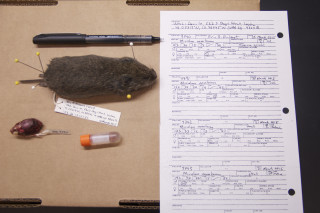Cataloging, storage, and research use
Step 4: Cataloging and Labeling Specimens
As the specimens are being prepared, proper documentation is needed in order to organize each individual specimen and be able to reference it in the future.

Each specimen has a label that is either tied to it or attached to the container holding it. Labels are written in a uniform manner so as to keep consistant, complete records. The picture to the right shows the information included in vertebrate specimen labels. The photo on the left shows how one animal can contribute to multiple specimen types (ie. study skin, skull/skeleton, DNA, etc.) Click the images to enlarge.
In the field, researchers keep accurate notes of their findings. Shown are examples of both the catalog and the itinerary that would be recorded. Click the image to enlarge.
Currently, the Museum is calling all interested volunteers to help transcribe our handwritten notebooks. Check out our project on DigiVol.
Step 5: Storage in the Collections Rooms
After the specimen has been accessioned in the museum (prepared and cataloged), it is then placed in the proper location in the collections rooms. The collections are organized in phylogenetic order (relation to each other in evolutionary history) and then alphabetically by location (country, state, county).
Step 6: Use in Research
The specimens are prepared and maintained in way in which they can be studied many years into the future. The Vertebrate Zoology department at NHMU receives several requests annually to use the collections for research purposes. The curator and collection manager review the requests and grant access to the collections as appropriate.